- Home
- Home Decor
4 Tips for Decorating With Muted Colors
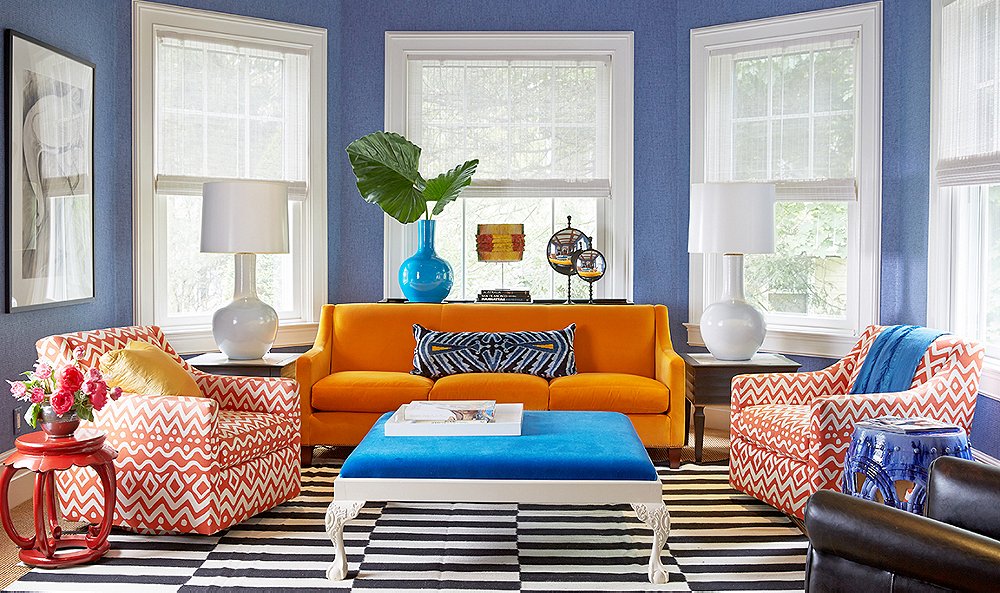
Soft pastels, earthy tones, faded shades of primary colors – it’s a shame that muted colors are still fairly underrated in interior design because they can bring a sense of tranquility, sophistication, and timelessness to interior design. Of course, this depends in large part on interior design decisions so here are 4 top tips for decorating with muted colors.
Introduce Texture and Pattern
With muted colors, one of the first things you want to do is to add depth because muted color palettes can sometimes appear flat or one-dimensional, and without depth a room with muted colors might feel dull or uninspiring.
Consider using materials like linen curtains, woolen throws, shaggy rugs, or a chunky knit blanket. Then, think about geometric designs, tone-on-tone patterns, or soft, organic prints for your upholstery, throw pillows, or even wallpaper. For example, many retirement communities decorate their rooms in muted colors to create a serene atmosphere for residents and a great way to add texture and patterns to such rooms is with herringbone upholstery, knitted throws, soft floral prints on cushions, etc.
Add Accents and Accessories
Even a single well-chosen accessory – a vibrant piece of artwork, an intricately designed vase – can enliven a muted-colored space.
Imagine a living room painted with soft gray walls and then a vibrant piece of abstract artwork injecting a burst of energy with rich blue and gold hues.
Go for accents and accessories with bolder colors or metallic finishes like gold, copper, or silver in the form of picture frames, or even a statement piece of furniture.
Pay Attention to Lighting
Lighting can do a lot in any room, especially ones with muted colors. Lighting in rooms with muted colors serves as both a practical necessity and a design tool because it enhances the inherent qualities of such color schemes while adding layers of visual interest.
Opt for warm-toned lighting with soft, diffused bulbs as they complement muted colors by creating a cozy atmosphere. You also want to use a combination of ambient, task, and accent lighting to create depth and functionality. Plus, the design of light fixtures can also contribute to the overall aesthetic. Think fabric shades, rattan, or metal with an aged finish.
Incorporate Natural Elements
Combining natural elements with muted colors is popular for a reason. For example, the combination of natural elements and muted colors often means a timeless design that transcends trends.
Start by adding wooden furniture or elements like exposed wooden beams, shelves, or flooring. Also, natural stone surfaces, like marble countertops or a slate fireplace, create visual contrast and a sense of sophistication.
Alternatively, you can also stick to simple indoor plants that not only add color but also purify the air.
Muted colors create a serene and timeless ambiance that makes them suitable for various design styles, from Scandinavian to traditional. So just experiment and adjust these design tips until you achieve the desired aesthetic for your space.
How To Design a Serene and Soothing Bathroom Atmosphere
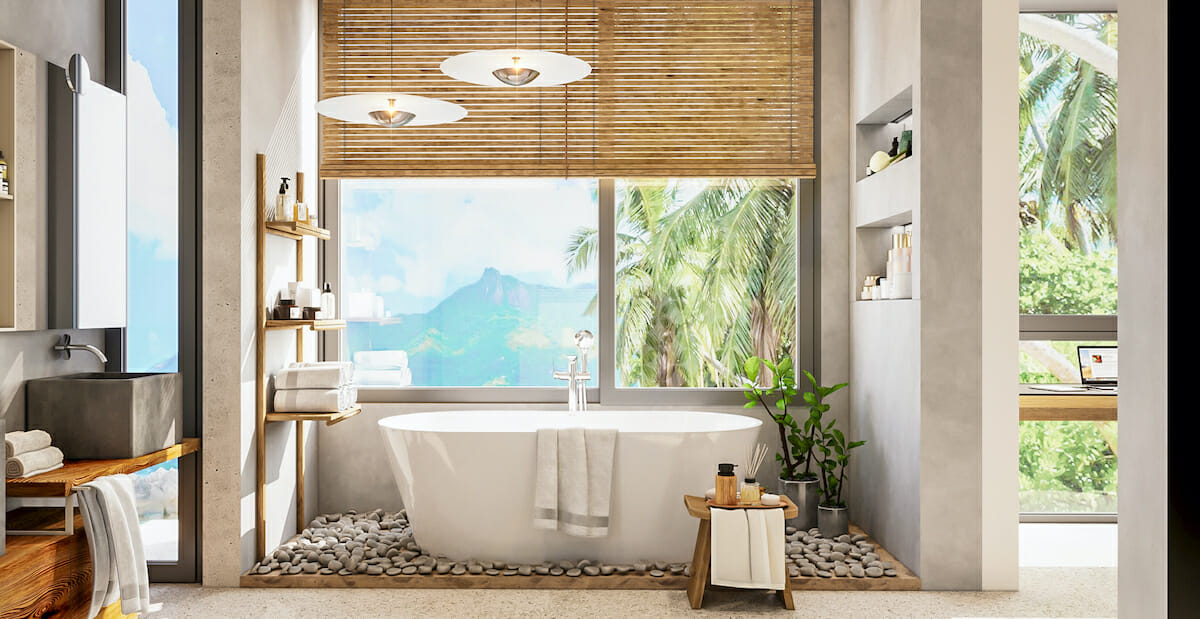
Your bathroom isn’t just for getting clean; it’s your personal escape. It’s where you kickstart and wind down each day. But creating a calming vibe is more than picking out cool fixtures; it should soothe your senses and relax the mind too. Let me show you how to turn this everyday spot into a peaceful retreat in no time.
Color Palette: Embrace Calm Tones
Choosing the right color for your bathroom plays a huge part in setting its vibe. Want to feel calm and relaxed? Go with muted, neutral, or pastel tones. Blue shades make you feel like you are stepping into a serene spa every time! Greens remind you of nature’s soothing presence even indoors.
On the other hand, earthy hues such as taupe or beige could give out warmth and coziness – imagine wrapping yourself up in comfort! Just one word of caution, though. Steer clear from colors that are too bright or dark. They can make small spaces like bathrooms seem quite chaotic at times.
Natural Elements: Incorporate the Outdoors
Nothing beats the calming effect of nature. Try adding natural elements like stone, wood, or bamboo to your bathroom. They don’t just bring the outdoors in but also add a unique texture and depth to space. It’s all about those little details! Think how cool a wooden bath mat would look, practical yet stylish.
Ferns or some fresh Aloe Vera can clean up air quality while giving that lush green vibe which will make you feel lively every time you step into your tranquil haven. Embrace the beauty that lies within these tiny additions and watch them transform this everyday spot completely.
Lighting: Set the Mood
Lighting can totally switch up a room’s feel. For your bathroom, where chilling out is the theme, think about popping in some dimmable lights. They let you tweak brightness to match just how chilled or alert you’re feeling.
Sheer window treatments have your privacy covered while letting sunshine stream through! When night falls and relaxation calls for an extra glowy vibe, consider candles or LED lanterns. There’s something so soothingly romantic yet meditative about their warm flickering light that’ll have all stress melting away as soon as one steps into this cozy haven of yours!
Functional Accessories: Enhance the Experience
Your bathroom isn’t just about looking good; useful accessories make a world of difference too. Imagine sinking into a deep tub for those long, pampering baths. Once you’re nestled in that warm water hug, who wants to break it? A top-notch bathtub stopper will keep the soak going without any surprise drain outs.
Now add ultra-soft towels – drying off never felt so luxurious! And remember relaxing needs its own soundtrack. Cue a waterproof Bluetooth speaker softly playing your favorite tunes. Plus, with bath trays holding your book or tablet, every bathing moment becomes more like personal spa time than an everyday chore.
Conclusion
So, a chill-out bathroom vibe needs both style and practicality. The perfect color picks, a sprinkle of natural elements, killer lighting choices, and handy accessories can turn your everyday bathroom into an oasis of calm.
3 Smart Ways To Hide All Of The Cords and Wires Throughout Your Home
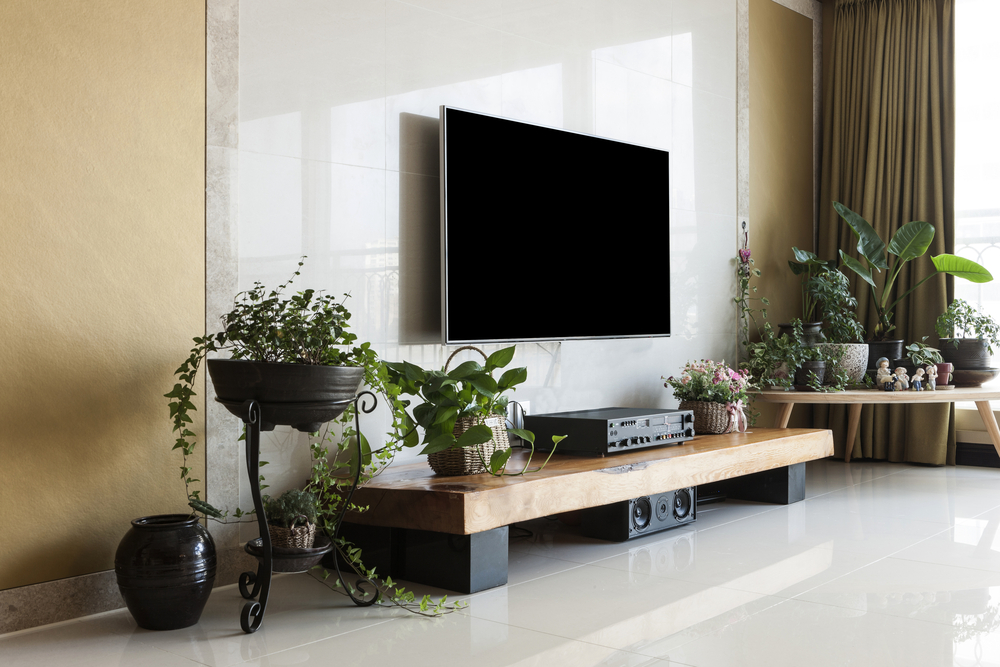
If your home is like most modern homes, then you likely have all kinds of cords and wires to plug in all of your appliances and other pieces of technology. And while you might love having all of these items, what you probably don’t love is having to figure out what to do with all of the cords and wires that come along with all of the stuff.
If not taken care of correctly, all of your electronics could cause major electrical issues and get in the way of your everyday life. So to help ensure that this doesn’t happen to you, here are three smart ways to hide all of the cords and wires throughout your home.
Use Your Furniture
In many situations, you likely have your appliances or electronics sitting on or near furniture pieces. If this is the case, something that you can do is to use your furniture to help you in hiding the cords and wires that are around your furniture.
To do this, you can either install hooks and clips all around the backside of the furniture so that you can feed your cords and wires through them and hide them behind the back or side of the furniture. Something else you can do is to just tape or otherwise cover the cords and wires behind the furniture so that they can’t be seen.
Create Bundles
For many people, one of the biggest issues with keeping cords and electronic wires out of sight is knowing which cords are for which item. This can be especially vital if you have to switch certain plugs occasionally.
To make this easier, something you can try is to create bundles for the cords that you’re using in close proximity. You can wrap all of the cords together in a bundle and then label the cords as they come out of the bundle so that you easily know which plug is for which item. And when the cords are all bundled together, they’ll be easier to hide and keep together.
Make A Charging Drawer
Another option for cords that are close to furniture is to empty out one of the drawers and make it a home for all lengths of cords and wires around that area. This way, everything will be completely enclosed in a space that no one will even suspect has cords and wires.
To make this easier, you might want to drill a hole in the back or bottom of the drawer so that you can easily feed the cords and wires into the drawer. But once you have this done, that drawer will be the perfect place to hide your cords.
If you’re tired of seeing cords and wires all over your house, consider using the tips mentioned above to help you learn how to best hide them from sight.
Top Trends for Modern and Classic Blinds of Every Style
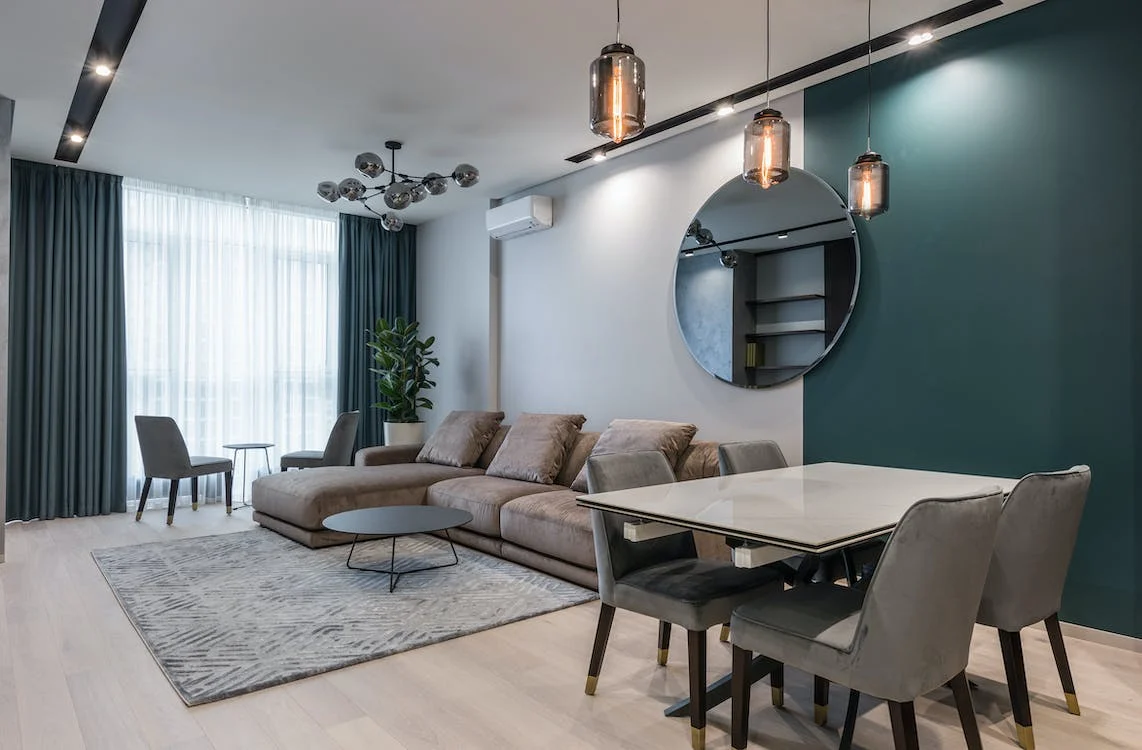
Window blinds are essential elements in our homes, serving both functional and aesthetic purposes. They offer privacy, control the amount of sunlight entering a room, and contribute to the overall ambiance of a space. As design trends evolve, staying up-to-date with the latest styles and options available in blinds is crucial. From quirky and contemporary to classic and timeless, there are vast trends to suit every style and preference.
In today’s blog, we will delve into the top trends for modern and classic blinds, one of them being roman blinds, providing suitable insights to help you make informed decisions when choosing window treatments. Whether you wish for a sleek and minimalist look to add a touch of elegance and sophistication or infuse a space with vibrant colors and patterns, there is a trend to suit your taste and transform your windows into captivating focal points.
Blinds made from natural materials and textures have recently gained significant popularity. For example, bamboo and woven wood blinds bring a natural and organic feel to any room, creating a sense of harmony with the environment. These natural materials are especially favored in interior styles such as bohemian, coastal, and Scandinavian, where the emphasis lies on creating a cozy and inviting atmosphere. They can also be customized according to your shape of window like vertical blinds.
Technology has also proven to the world of window blinds. Motorization and smart controls have become prevalent, offering convenience and enhanced functionality. With motorized blinds, you can efficiently operate them with a remote control, smartphone app, or even voice commands, adding an element of modern innovation to your home. Smart blinds can be operated to open and close at specific times, adjust to changing natural light, and integrate with your home automation system, making your life more comfortable and efficient.
- Natural Materials and Textures: One of the prominent trends in blinds is using raw materials and textures. Bamboo and woven wood blinds bring any space an earthy and organic feel. These blinds complement various interior styles, such as bohemian, coastal, and Scandinavian. Natural materials add warmth and curate a sense of harmony with the environment.
- Motorization and Smart Controls: Technology integration in home decor has revolutionized how we operate our blinds, just like roller blinds. Motorized blinds offer convenience and smoothness, allowing you to control them with a remote, smartphone app, or voice commands. Smart blinds can be set in a specific way to open and close at curated times, adjust to natural light, and even sync with your home automation system. This trend combines functionality with modern innovation, making your life more comfortable and efficient.
- Bold Colors and Patterns: Blinds are no longer limited to neutral shades. Vibrant colors and patterns are making a significant comeback. Bold-colored blinds can serve as focal points, adding a pop of personality to your space. Patterned blinds, such as geometric designs or floral motifs, create visual interest and can complement a wide range of interior styles. Experimenting with colors and patterns allows you to express individuality and create a unique ambiance.
- Layering and Combinations: Mixing and matching different types of blinds is a popular trend in window treatments. Layering blinds can provide enhanced light control and privacy options. For example, combining sheer blinds with blackout curtains allows you to enjoy diffused natural light during the day while maintaining privacy in the evening. This trend offers versatility in design and functionality, allowing you to customize your window treatments according to your needs.
- Sustainability and Eco-Friendly Materials: As environmental awareness grows, so does the demand for eco-friendly blinds. Sustainable materials like organic cotton, linen, and recycled fabrics are gaining popularity. These materials reduce the ecological footprint and contribute to a healthier indoor environment. Choosing blinds from sustainable sources aligns with the growing trend of conscious consumption and sustainable living.
- Minimalist and Clean Lines: Minimalism continues to influence modern interior design, and blinds are no exception. Clean lines and sleek designs contribute to a minimalist aesthetic. Roller blinds, cellular shades, and Venetian blinds with slim profiles are ideal for achieving a minimalist look. These blinds provide timeless elegance and can seamlessly integrate into various design styles.
- Classic Elegance: While modern trends thrive, classic styles remain fashionable. Roman blinds and traditional curtains with elegant fabrics and drapery details add a touch of sophistication to any space. Classic blinds can complement both contemporary and traditional interiors, offering a sense of timelessness and refinement.
Conclusion:
Keeping up with the top trends for modern and classic blinds allows you to create a stylish and functional window treatment that complements your interior design. Whether you prefer natural materials, bold colors, or minimalist aesthetics, there is a trend to suit your taste. By incorporating one or a few of many trends into your home, you can elevate the look of your windows while enjoying the benefits of privacy, light control, and energy efficiency.
Display Home Strategy: 6 Tips for Making the Most of Display Home Visits
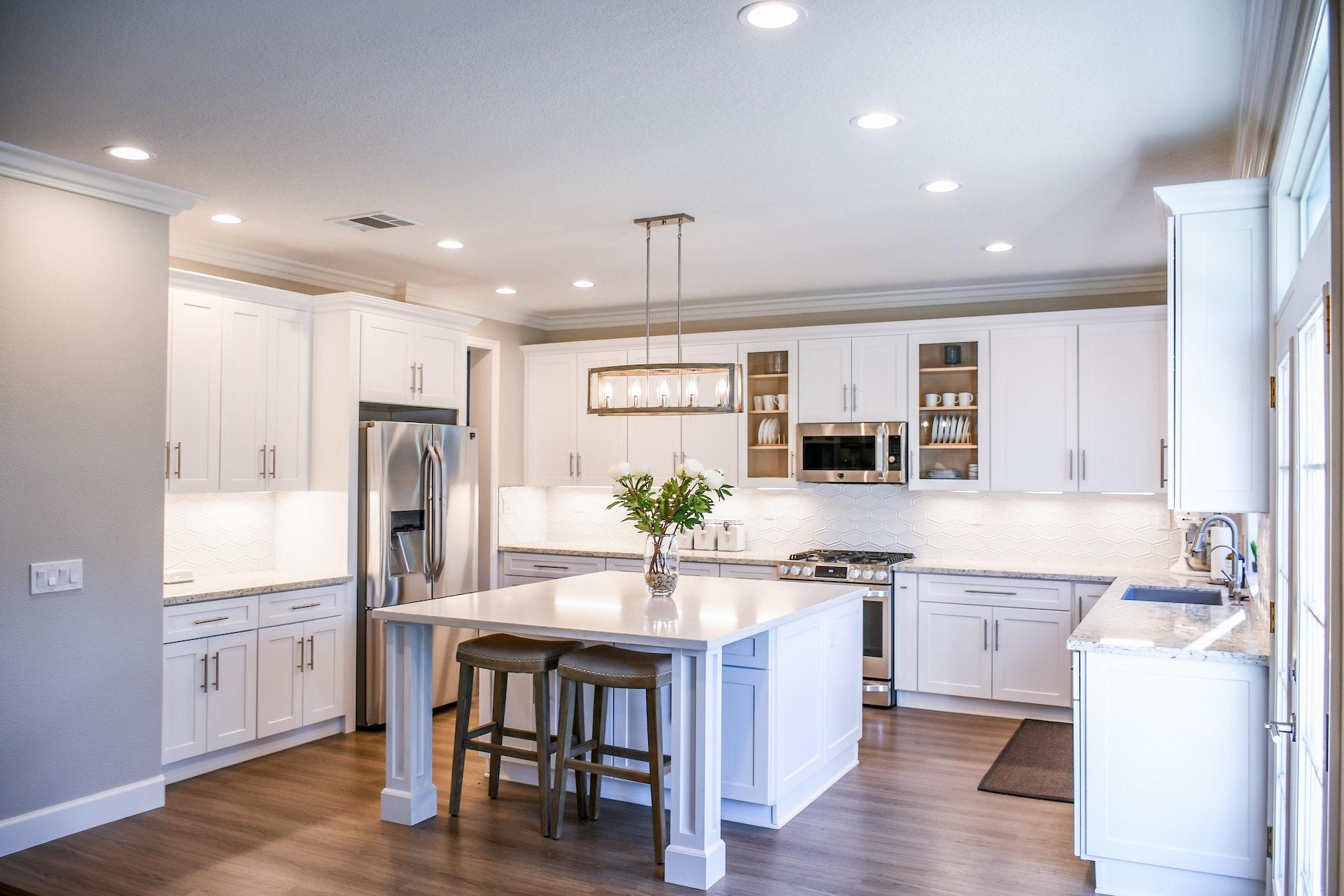
If you’re in the market for a house, it’s best to visit a few beforehand. Whether it’s walking through the best display homes Torquay has to offer or taking a quick peek at apartments in Thailand, it helps to get a real-world feel for what your dream home might look like. Before making that visit, however, it’s best to prepare yourself.
Below are six tips for doing so:
1. Know your budget
Before heading over to the display home, know what you can and can’t afford, and keep that range in focus. This will allow you to confidently explore the property and all its features while knowing it’s the right financial fit.
To get a handle on your budget, talk to a few banks and lenders to get a rough estimate of what’s a reasonable price for you. Even if the first bank you visit is ideal, shop around a bit so you can compare different offers and make the most informed decision possible.
2. Know your needs
Needs and budgets differ from person to person. What essentials do you require in your home right now and in the future? If you’re starting a family or already have one, that may mean extra room and storage space. If you’re big on barbeques and regular gatherings, then plenty of indoor and outdoor seating may be required, as will an attractive garden and spacious yard.
Alongside your essentials, it’s important to consider where you’re willing to compromise. In other words, distinguish what you need from what’s nice to have. Identifying these beforehand will clarify your goals and ensure your home fits your needs.
3. Research the builders
Just as you would research a brand before buying expensive electronics, you must research the builders behind any display homes you visit. Ideally, the company has a sterling reputation and is known for its build quality, customer service, and warranties.
You can find that information online by searching through forums. In addition, you can tap into your friend and family networks to get personal recommendations based on their experiences.
4. Take your time
Take a few deep breaths, walk around the place, and take it all in. Don’t rush your visit. Instead, get a feel for what it would be like to live there. As you walk around the kitchen, living room, and bedroom, imagine how you would arrange each room. Is there enough space for a comfy sofa in the living room, or is it a bit cramped? Pay attention to details like this to ensure everything meets your standards.
5. Walk around the outside
In addition to a thorough inspection of the display home’s interior, it’s essential to walk around the outside as well. This is another way to get a feel for the builders in charge of making your dream home. Is the site well-managed and tidy, or is it a mess? Furthermore, keep an eye out for any awards that show their build quality has been recognized by the industry.
6. Learn about the wider community
After you’ve checked the inside and outside of the display home, learn about the wider community. If you have young ones, you may want to know about parks, playgrounds, and open spaces alongside schools. Furthermore, are shops, doctors, and other essential services nearby? These answers can help you decide whether the community is a good fit for you.
Visiting a display home is an exciting part of the house-buying journey. Keep the six tips above in mind to make the most of it.
Clean Throughout the Week and Leave the Weekend Free

You work hard all week and you want to look forward to some rest. By the time the weekend comes, you are ready for some relaxation. You do not want to spend your weekend cleaning your custom pocket doors and tile floors and doing other chores that will take up all your time. If you spend your time wisely during the week, you should be able to look forward to your weekend and really enjoy it.
Keeping a house clean is a task that requires dedication and consistency. With the right cleaning steps during the week, it is possible to maintain a tidy and organized home without spending hours on end cleaning. Here are some tips for a weekly cleaning routine that will help you keep your home in top condition.
Monday: Tackle the Kitchen
The kitchen is often the heart of the home, but it is also one of the most challenging areas to keep clean. Therefore, start your week by giving your kitchen a thorough clean. Begin by decluttering the countertops and cleaning any dirty dishes. Wipe down the stove, microwave, and refrigerator, and sanitize the sink area. Use a microfiber cloth to dust off the cabinets and sweep the floor. By starting the week with a clean kitchen, you will feel motivated to keep the rest of the house tidy.
Tuesday: Focus on the Bedrooms
Bedrooms should be a haven for relaxation, but it is challenging to unwind in a cluttered and messy room. Dedicate Tuesdays to cleaning the bedrooms. Begin by changing the bed sheets and pillowcases. Then, declutter the surfaces and put away any misplaced items. Dust the furniture, clean the mirrors and vacuum the floors. A clean and organized bedroom promotes better sleep, which is essential for overall health and well-being.
Wednesday: Clean the Bathrooms
The bathrooms are another area that requires consistent cleaning. Spend Wednesday tackling the toilets, sinks, and showers. Scrub the toilets with a disinfectant cleaner and wipe down the sinks and countertops. Clean the shower or bathtub with a mildew remover and replace the towels. Sweep and mop the floors and use an air freshener to keep the space smelling fresh.
Thursday: Tidy up the Living Room
The living room is often where families spend the most time, and it can quickly become cluttered with toys, books, and other items. Take Thursdays to tidy up the living room. Begin by decluttering the space, putting away any misplaced items, and dusting the surfaces. Vacuum or sweep the floors, and fluff up the cushions and pillows. A tidy living room makes the space more inviting and conducive to relaxation.
Friday: Do a Deep Clean
Friday is the perfect day to do a deep clean in the areas that require extra attention. For instance, take this day to scrub the floors, dust the blinds, and clean the windows. Wipe down the baseboards, clean the inside of the cabinets, and sanitize the doorknobs and light switches. By doing a deep clean every Friday, you will prevent dirt and grime from accumulating over time.
Saturday: Tackle the Outdoors
If you have a garden or outdoor space, spend Saturdays taking care of it. Mow the lawn, water the plants, and weed the garden. Sweep the patio or deck, and clean the outdoor furniture. By maintaining your outdoor space, you will improve the curb appeal of your home and create an enjoyable space to relax and entertain.
Sunday: Rest and Relax
After a week of consistent cleaning, take Sundays to rest and relax. Spend time with your family, pursue hobbies, and recharge your batteries. You deserve a break after a week of hard work, and taking a day off will help you maintain your motivation and energy levels.
In conclusion, cleaning steps during the week can make a significant difference in keeping your home tidy and organized. By breaking down the cleaning tasks into smaller daily and weekly goals, you can prevent dirt and grime from accumulating and enjoy a clean and inviting home. Consistency is key, so make sure to stick to your cleaning routine, and you will be rewarded with a clean, stress-free home.
How to Decorate Your Dining Room for Christmas

Christmas is the perfect time to get your home dressed up and looking great, and the dining room is arguably one of the most important rooms of the home on the big day. It is the room where most households get together to share a hearty Christmas meal. Here are a few top tips to help you decorate your dining room for Christmas.
Create a Festive Table Display
When the big day arrives, and everyone gathers around the table, you want to make sure your table is Christmas-ready. Master the art of tablescaping this Christmas, and decorate the full length of your table. Themed dinnerware, such as matching festive plates and bowls, can make your table look elegant and inviting. Add quality glassware, classy cutlery, and napkins to set off the look. The theme should center on Christmas, but you can achieve a sophisticated aesthetic by sticking with a traditional color palette, such as deep reds with gold accents. You can add to the table décor with pretty candles, leafy garlands, and rustic wooden table decorations.
Top it Off with a Beautiful Centerpiece
Top your table display off with an eye-catching Christmas table centerpiece. Whether bold and beautiful is your thing or you’re more au natural, pick a centerpiece that speaks to your style and complements the rest of your table display. A simple flower display in seasonal colors is a classic way to set off your table, while large cloches filled with Christmas decorations and grand candelabras can add height to your display.
Keep Your Dining Room Tidy with a Sideboard
When it comes to festive décor, some people shy away from it all because of the aftermath. Yes, a beatifically presented table and a stunning centerpiece are all good and well during the festive season, but where will it all go the rest of the year? That’s where sideboards step in. Sideboards are the perfect piece of furniture for people who need extra storage space and an extra surface too. You can keep seasonal tableware on a sideboard, and you can use the surface as a space to serve food too. Ligne Roset Furniture Bromley has a contemporary selection of sideboards to choose from. They are an established name in interior design, and their pieces will look great in the home all year round.
Make the Most of Your Windows
Besides a festive table display, there are other areas of the dining room that can be dolled up too. Windows are sometimes a neglected part of the room, but they are a great place for hanging up lights. A lit-up star with soft light can offer soft illumination to the dining room as well as to the outside of your home.
Add a Festive Glow
Besides hanging up lights on the windows, you can add a festive glow to the room with light displays on the surfaces. Twinkling string lights can also look sweet and atmospheric when draped on the walls. Lights are an excellent way to spread festive cheer in the home.
3 Tips For Learning About Interior Design For The First Time
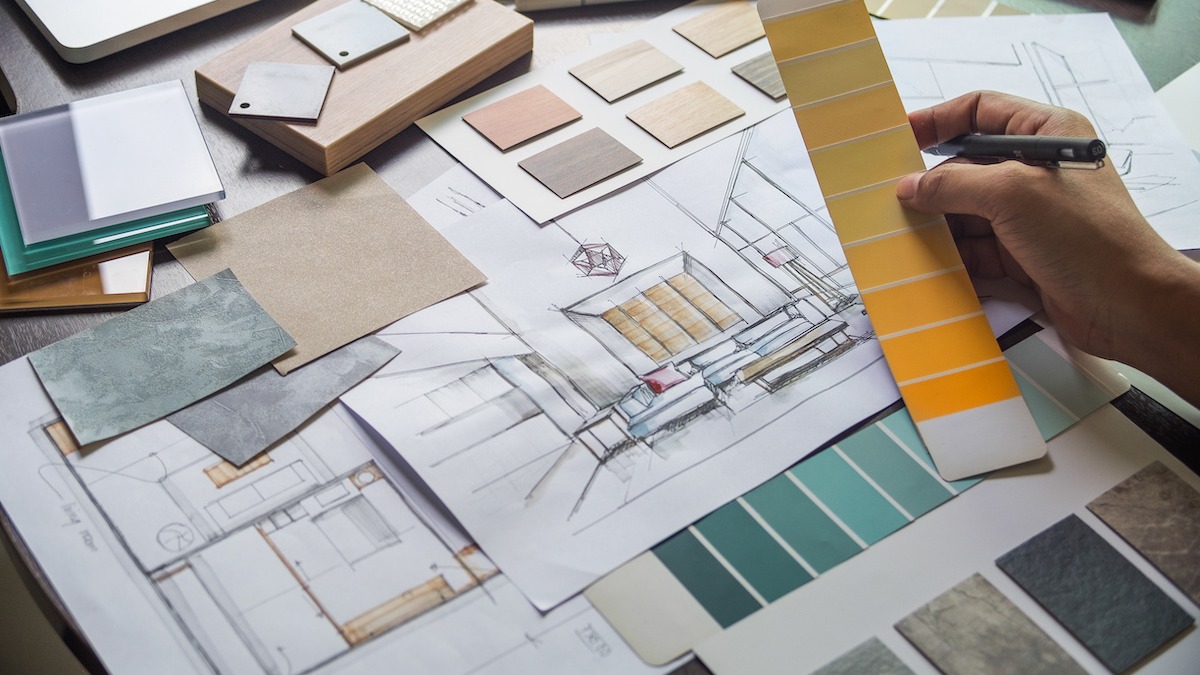
If you’re ready to try your hand at interior design, be it as a way to design your own home or as a potential career that you might be interested in, there are a few things that you should learn as you’re starting out. Luckily, these things are very basic and can help you have a solid foundation to further build your experience at interior design.
To show you just what these things are, here are three tips for learning about interior design for the first time.
Start With The Basics
As you’re getting ready to learn more about interior design, the best place to start is with the basics.
Some of the basic principles of interior design include finding a style, choosing a focal point, and creating balance. To give yourself a jumping off point for all of these things, you might want to spend some time reading interior design articles that can give you some information about them and how to implement them into your own designs.
Until you really get some practice using all of these basic principles of design, you might have a hard time really seeing how they work together as the fundamentals of interior design. But once you’re able to incorporate the principles of style, focal point, and balance into the decisions that you make when designing a space, you’ll start to really get a handle on interior design.
Work From A Mood Board
For most people just starting off with interior design, there’s going to be a lot more time that goes into the planning aspects than they might expect.
To help you with this planning, you should consider creating mood boards that you’re able to work from. For every space that you’re going to be designing, put together a board full of your inspiration and the design elements that you want to incorporate into this space. Then, as you seek to find the actual pieces that you’ll be using, you can refer back to your mood board to determine if everything fits together as you’d imagined.
Embrace An Eclectic Style
One thing that many amateur interior designers tend to lean too hard on is matching. While it can be good to have certain parts of your design match or be complementary, having too many things that are matchy-matchy is a sure sign of an interior designer who doesn’t trust themselves.
To fight against this desire to match, you should try to embrace a more eclectic style. Look for elements that you like that also fit well on your mood boards. Try not to use many things that come in sets to really push yourself and your design eye to find what works for you and your specific space.
If you’re ready to start learning about interior design for the first time, consider using the tips mentioned above to help you see where to begin.
3 Things You Can Do To Help Reduce Moisture And Humidity In Your Home
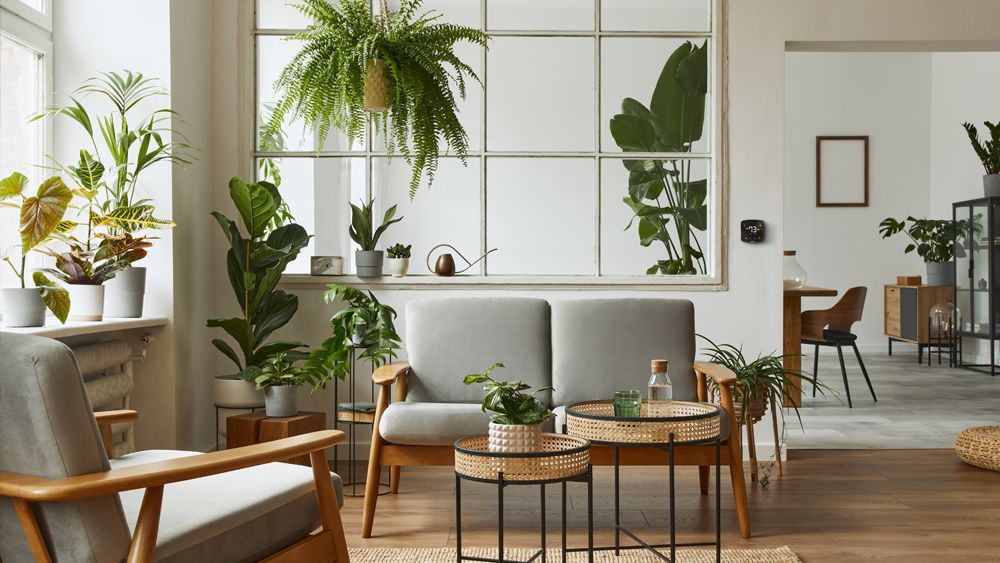
Unless you need moisture and humidity to accomplish the task set before you, it’s best not to have more moisture or humidity than is necessary. Both in residential and commercial capacities, having moisture in your home or in things like compressed air lines can cause a lot of damage. But luckily, there are things you can do to help cut down on the amount of moisture that your home or equipment is exposed to.
To help you see how this can be done, here are three things you can do to help reduce moisture and humidity in your home.
Start From The Ground Up
If you’ve noticed that there is more moisture in your home than you would like, you should start addressing this problem from the ground up.
In many places where the atmosphere and environment holds more moisture than you’d like it to, that moisture can get into your home both from the air and from the ground. So if you have any exposed ground under or around your home, the moisture coming up from these areas can cause your home to hold more moisture, too.
If this is the case for your home, try putting plastic covers over any exposed earth, like in the crawlspace of your home. This will help to put a barrier between the moisture of the ground and the bottom of your home. Additionally, you’ll want to make sure that there is good ventilation in these areas as well.
Set Up A Smart Thermostat
For homes with a smart thermostat, you can set the device to check the amount of humidity in your home and then turn on your air conditioner to make sure the humidity is set at the level that you want. When the cold air of your air conditioner turns on, it can help to reduce the humidity. And when you set this through your smart thermostat, you won’t have to worry about making any adjustments on your own anymore.
If you don’t already have a smart thermostat and are experiencing issues with humidity in your home, you might want to consider investing in one of these devices to help you with your problem.
Use All Of Your Fans
Getting any kind of air movement going through your home can also help when humidity levels get high.
Not only can putting in ceiling fans or things like box fans or oscillating fans help, but turning on any exhaust fans in your kitchen and bathroom can help to bring down the levels of humidity in your house as well.
If you live in a humid area and often find this humidity penetrating into your home, consider using the tips mentioned above to help you learn how you can reduce the humidity within your house.
5 Best Ways to Get Rid of Rats and Mice in Your House

Do you have little ones at home? Do you spend most of your time indoors? If so, then your home is probably home to plenty of rats and mice. You might even see these little guys around your house from time to sit. Even if they aren’t causing you any harm, there are some pesky little critters that will quickly make their way inside if given the chance. Along with bringing in unwanted pests and making it a more unpleasant place to be, they can also spread disease and leave you feeling anxious as well as vulnerable. And since their presence might also mean that other animals like raccoons are coming around as well, then this means that you’ll need to take steps to get rid of them as well. Here are the best ways to get rid of rats and mice from your house.
Get Rid of the Source:
If you want to get rid of rats and mice from your home, you’ll need to get rid of the source. The fact is that these pests are attracted to food and water sources, so if you have a food or water source that you’re able to seal off, then you’ll be able to significantly reduce the chance of them making their way into your home. If you’re able to do this, you’ll need to focus on keeping these items in a secure location, like a locked cupboard. By doing this, you’ll be able to stop rats and mice from finding easy access to them. Additionally, you’ll also want to be sure that you clean any surfaces that you store foods and drinks on regularly. This is important, because if you’re able to get rid of the source of rats and mice, then they won’t have anywhere to go. And while they might not be inside your home, they can still be outside.
Seal All Entry Points
If you’ve got rats and mice getting inside your home, then you’ll want to make sure that you seal off the entry points. This will mean that they’ll have to dig through your walls in order to find a way inside. This is a far less likely scenario, as they’ll likely be deterred by the lack of easy access to food and water. Keep all your pipes, drains, and windows closed. Make sure that you don’t leave any gaps in your walls, and that you make sure that any gaps under your doors are kept tight. This will help to keep out pesky rodents, and keep them from finding a way inside. You’ll also want to make sure that you clean and sanitize all areas that you use regularly. And, like with sealing access points, you’ll also want to make sure that your cleaning products are out where rodents can’t get to them.
Vacuum Regularly
When you have pests like rats and mice running around your home, you’ll want to make sure that you regularly clean out any areas that they might be able to get into. This means that you’ll want to make sure that you vacuum regularly, and that you clean out any areas that you regularly use. You’ll want to make sure that you clean out your vacuum regularly, and that you keep all of your cord lengths and outlets covered. This will help to keep rodents out of your home, and will also help to keep them out of your vacuum cleaner. You’ll also want to make sure that you clean all areas that you regularly use. This means that you’ll want to make sure that you clean out your sinks, toilets and other places where rodents might be able to hide. This is an important step, because if you’re able to keep regular areas clean, and keep your vacuum and cleaning tools away from rodents, you’ll be able to keep them out of your house.
Set Out Freezing Mats and Screeches
One of the best ways to get rid of rats and mice from your home is to set up a freezing mat. These allow you to catch any critters that you might have running around, and you’ll be able to do this without worrying about harming them. All you have to do is set one of these out on a sturdy surface, like the floor, and leave it there for a few days. This will allow it to get very cold; too cold for most rodents to survive in. Another great way to get rid of rats and mice, especially from areas like your deck or patio, is to use a screech. These are great for outdoor areas, as they emit a piercing sound that you’ll be able to hear from anywhere in your house. This means that you’ll be able to quickly locate rodents, and will help to ensure that they aren’t getting into your home either. Both of these methods will help to keep critters like rats and mice out of your home, and will allow you to keep them out of your yard. This is a great way to ensure that you can keep your family safe, and safe from these pests.
Final Words
Rats and mice can be a nuisance in your home, but they can also trigger disease. And, if they are allowed to nest in your home, they can damage your property and eat your food. They are crafty and adaptable little creatures that can easily find a way inside your home, and if they make it inside, they can cause major damage. If you have a problem with rats and mice getting into your home, then you’ll want to make sure that you do whatever you can to get rid of them as quickly as possible. And, by following these steps, you can quickly get rid of these pests from your home without causing any damage.










